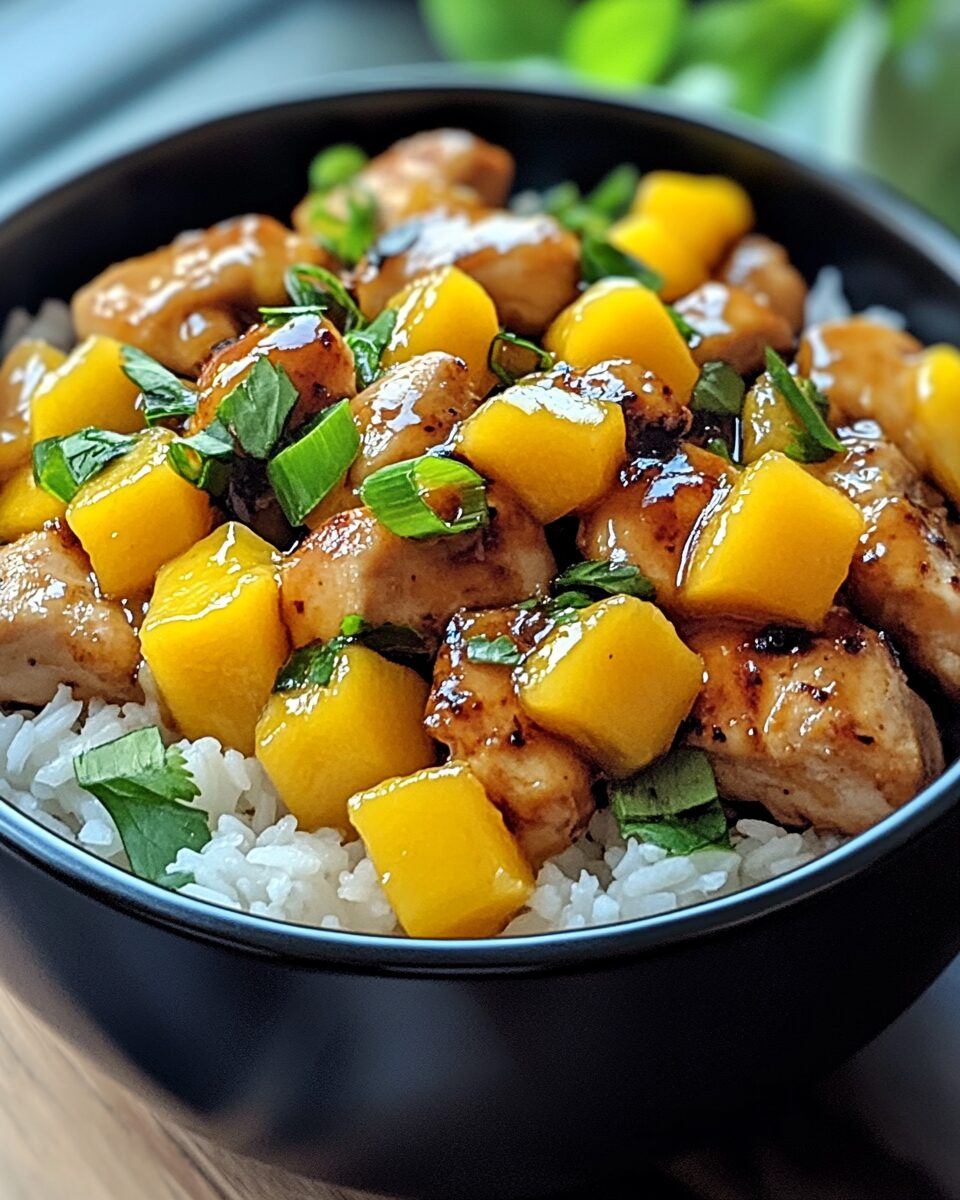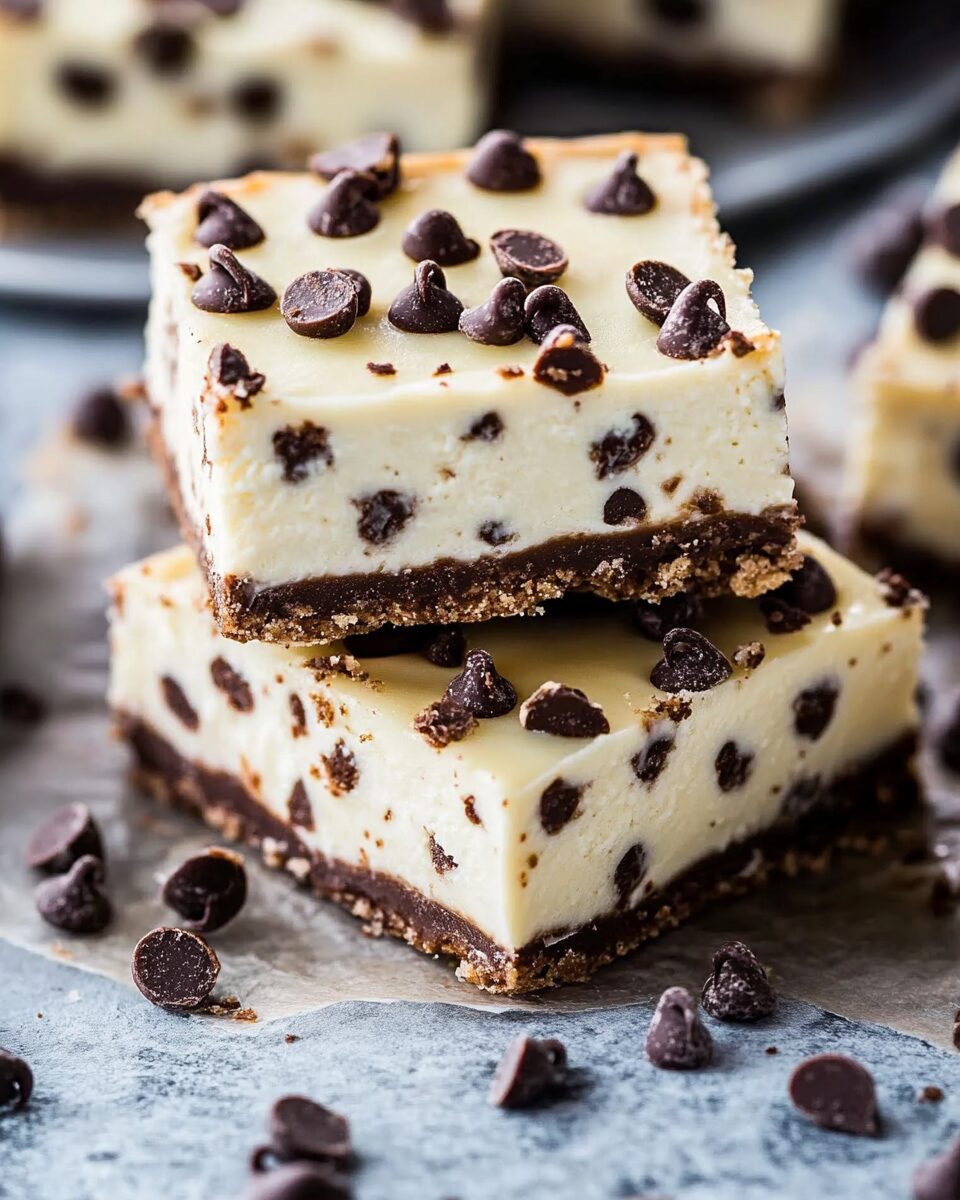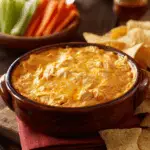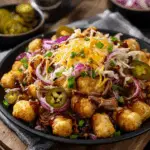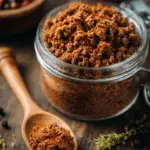The vibrant flavor of this Asian Mango Chicken is the perfect combination of sweet, savory, and spicy. With juicy ripe mangoes blended into a rich sauce of soy, garlic, and ginger, it wraps each piece of chicken in a tropical-inspired glaze that bursts with flavor.
Ready in under 35 minutes, it’s the ideal recipe for weeknights when you want something delicious and impressive but quick to prepare. Whether served over jasmine rice or paired with stir-fried veggies, this dish is guaranteed to become a new favorite in your kitchen.
Full Recipe:
For the Marinade and Sauce:
-
2 ripe mangoes, peeled, pitted, and chopped
-
3 tablespoons soy sauce (Halal)
-
2 tablespoons honey or maple syrup
-
1 tablespoon rice vinegar
-
1 tablespoon olive or vegetable oil
-
2 teaspoons fresh grated ginger
-
2 cloves garlic, minced
-
1 teaspoon chili paste or sauce (optional)
-
1 tablespoon cornstarch
-
½ cup water or chicken broth
For the Chicken:
-
4 boneless, skinless chicken breasts or thighs
-
1 tablespoon olive oil (for cooking)
-
Salt and pepper to taste
Directions:
-
Season the chicken with salt and pepper; set aside.
-
Cook Chicken: Heat 1 tbsp olive oil in a large skillet over medium heat. Cook chicken for 6–7 minutes per side until golden and fully cooked (165°F/74°C). Remove and rest.
-
Make Sauce: While chicken cooks, blend mango, soy sauce, honey, vinegar, ginger, garlic, and chili paste until smooth.
-
Thicken: Pour mixture into a saucepan. In a small bowl, mix cornstarch with 2 tbsp water or broth. Stir into the mango mixture and heat, stirring, until thickened (3–5 min).
-
Combine: Return chicken to skillet, pour sauce over, and simmer 2–3 minutes.
-
Serve: Slice or serve whole, drizzled with extra sauce and optional fresh cilantro or green onions.
Prep Time: 10 minutes | Cooking Time: 25 minutes | Total Time: 35 minutes
Kcal: 375 kcal (avg) | Servings: 4 servings
An Introduction to Asian Mango Chicken
Asian Mango Chicken is a vibrant, tropical-inspired dish that masterfully blends sweet, savory, and mildly spicy flavors into a memorable culinary experience. Originating as a fusion of Southeast Asian flavor profiles, this recipe has become a global favorite thanks to its freshness, bold taste, and ease of preparation.
At its core, this dish combines ripe mangoes—known for their natural sweetness and smooth texture—with traditional Asian ingredients like soy sauce, ginger, garlic, and rice vinegar. The result is a rich and flavorful glaze that coats tender, juicy chicken, creating a satisfying main course that’s perfect for a variety of occasions.
Whether you’re looking to spice up your weekly meal plan or serve something exotic at your next dinner party, Asian Mango Chicken delivers on taste, aroma, and visual appeal.
The Appeal of Mango in Savory Dishes
Using fruit in savory dishes is a culinary tradition found across many cultures. Mango, in particular, pairs well with salty, spicy, and tangy elements due to its natural balance of sweetness and acidity. In Asian cuisine, mango is often used to temper the heat of chili-based sauces or to add a juicy texture contrast in stir-fries and salads.
In this recipe, mango doesn’t just sit on the side as a garnish or topping—it forms the foundation of the sauce. Blended with aromatics and seasoning, it creates a luxurious coating for the chicken that’s both refreshing and indulgent. This not only enhances the dish’s taste but also introduces a silky texture that elevates each bite.
Why This Dish Works So Well
Several elements come together to make Asian Mango Chicken a standout meal. First is the balance of flavor. The mango offers a natural sweetness that’s complemented by the umami depth of soy sauce and the warmth of fresh ginger and garlic. A touch of chili paste adds just enough heat to round things out, while rice vinegar brings acidity to balance the sweetness.
Second is the texture. The sauce is thickened slightly with cornstarch, giving it a smooth, glossy finish that clings perfectly to the chicken. This makes every bite flavorful and juicy without being overly rich or heavy.
Lastly, the method of cooking—typically pan-searing or grilling—adds a savory caramelization to the chicken’s surface, enhancing the dish’s overall complexity without requiring advanced culinary skills or specialty equipment.
Cultural Influences and Origins
While not traditionally found in one specific Asian cuisine, Asian Mango Chicken is an example of Asian fusion cooking, which takes inspiration from a variety of regional dishes across China, Thailand, Vietnam, and the Philippines. Mango is a fruit native to South and Southeast Asia and features prominently in the local cuisines.
In Thailand, for example, mango is often paired with sticky rice for dessert but also finds its way into spicy salads. In the Philippines, mango is used in savory marinades for grilled meats. Drawing on these traditions, this dish synthesizes these ideas into a modern, accessible meal that anyone can recreate at home.
The popularity of fusion recipes like Asian Mango Chicken reflects global food trends that prioritize flavor diversity, freshness, and a blend of cultural influences. It’s perfect for home cooks who want to explore new culinary territories without stepping too far outside their comfort zone.
Nutritional Highlights
Asian Mango Chicken isn’t just delicious—it’s also relatively healthy when prepared with fresh, whole ingredients. A typical serving contains around 350 to 400 calories, making it suitable for a balanced lunch or dinner.
Here are some of the key nutritional benefits:
-
Protein-Rich: Chicken provides lean protein, which supports muscle growth, satiety, and overall wellness.
-
Low in Saturated Fat: By using skinless chicken breasts or thighs and a minimal amount of oil, the fat content remains reasonable.
-
Vitamin-Rich Sauce: Mangoes are a great source of vitamins A and C, antioxidants that support skin health and immune function.
-
No Artificial Ingredients: When prepared at home, the dish contains no preservatives, artificial colors, or unhealthy additives.
Those following specific diets can also make easy modifications. For example, using tamari instead of soy sauce makes the dish gluten-free, and substituting tofu or tempeh for the chicken creates a vegetarian-friendly alternative.
Perfect Pairings and Serving Suggestions
Asian Mango Chicken is versatile enough to serve with a wide variety of side dishes. Its bold flavor pairs well with neutral or subtly flavored sides that won’t compete for attention.
Some ideal accompaniments include:
-
Steamed Jasmine or Basmati Rice: The subtle fragrance and fluffy texture of these rices are a perfect base for the saucy chicken.
-
Rice Noodles or Glass Noodles: Great for soaking up the sauce while offering a different textural experience.
-
Steamed or Stir-Fried Vegetables: Bok choy, snap peas, bell peppers, or broccoli add color and crunch to the plate.
-
Lettuce Wraps: For a low-carb option, wrap slices of mango chicken in large lettuce leaves and top with herbs and sesame seeds.
The dish also makes for great leftovers. Cold mango chicken can be sliced and used in sandwiches, wraps, or salads the next day, making it ideal for meal prepping.
Tips for Success
Although Asian Mango Chicken is a relatively straightforward recipe, a few simple techniques can help you get the best results every time:
-
Use Ripe Mangoes: A fully ripe mango will be slightly soft to the touch and have a fragrant aroma. This ensures maximum sweetness and smooth blending.
-
Don’t Overcook the Chicken: Whether you’re using breasts or thighs, make sure to cook the meat just until it’s done. Overcooking can dry out the chicken and make it tough.
-
Adjust the Heat to Taste: If you’re sensitive to spice, reduce or omit the chili paste. If you love heat, add extra or throw in some chopped fresh chilies.
-
Make the Sauce Ahead: The mango sauce can be prepared in advance and stored in the fridge for up to three days. This makes dinner prep even quicker on a busy night.
-
Garnish Smartly: A sprinkle of chopped cilantro, sliced green onions, or sesame seeds adds a pop of color and fresh flavor.
Why It’s Great for Entertaining
Asian Mango Chicken isn’t just for weeknights—it’s also an excellent option for parties or family gatherings. Its colorful appearance, bold flavors, and unique ingredients make it a conversation starter.
Serve it family-style with several sides and let your guests build their own plates. You can even double the recipe easily to feed a larger crowd. Since the sauce can be made ahead of time, most of the work can be done before guests arrive, leaving you free to enjoy the occasion.
Presentation matters, too—consider plating the chicken over a bed of rice and topping it with a drizzle of extra sauce and a handful of fresh herbs. It looks and tastes like something straight from a restaurant kitchen.
Storage and Leftover Ideas
Proper storage can extend the life of your Asian Mango Chicken and provide a few easy meals throughout the week. Once cooled, the chicken and sauce can be stored in an airtight container in the refrigerator for up to three days.
Here are some creative ways to use leftovers:
-
Wrap It Up: Use in tortillas or flatbread with lettuce and sliced cucumber for a fresh wrap.
-
Toss It in a Salad: Add cold mango chicken to a bowl of mixed greens with avocado and sesame dressing.
-
Reheat for Lunch: Warm in a skillet with a splash of water to loosen the sauce, and serve over noodles or rice.
Freezing is possible, although the mango sauce may lose some of its texture. If freezing, consider storing the chicken and sauce separately and reheating gently to preserve quality.
Conclusion
Asian Mango Chicken is a flavorful, colorful, and satisfying dish that showcases the beauty of fusion cooking. Combining the tropical sweetness of ripe mangoes with savory soy, zesty ginger, and optional chili heat, it’s a recipe that feels both exotic and comforting.
With just a few basic ingredients and under 40 minutes of cooking time, this dish is accessible even to beginner home cooks. It’s ideal for busy weeknights, family dinners, or even special occasions. Plus, it’s easy to adapt for dietary preferences and tastes, making it one of the most versatile dishes in the modern home kitchen.
Whether you’re new to cooking with mango or a longtime fan of Asian-inspired meals, this recipe is sure to become a beloved staple in your rotation. Give it a try, and bring a burst of tropical flavor to your next meal.

